Gallaudet invented the huddle. Now, the Bison are revolutionizing helmet tech with AT&T
On a cloudy fall day in Washington, D.C., Brandon Washington lit up the field with an electric 63-yard touchdown run. On his third offensive play of the game, the quarterback took the snap, scampered through the line of scrimmage and sprinted his way straight down the middle of the field all the way to the end zone.
Not only was it the Gallaudet Bison’s first score of the day, but it was the first touchdown for the 5G-connected helmet, a technology the world’s only liberal arts university for deaf and hard-of-hearing students developed with AT&T. Wearing the helmet, a player doesn’t have to hear a play call, but can see it.
"It was great, cushioned on the inside. It really fits my head," Washington told USA TODAY Sports of the helmet, which went through several iterations before game day. "The lens is not too big or too small, so I can see really, really good out of it. I really love the helmet.”
After Washington and the Bison beat the Hilbert Hawks 34-20 in the Oct. 7 home game at Hotchkiss Field, the junior was named the Eastern Collegiate Football Conference co-offensive player of the week for putting up 124 rushing yards and three touchdowns.
"Brandon is one of the most electrifying players that we've had come through here," Coach Chuck Goldstein said. "He’s pretty special and talented.”
AT&T's Chief Marketing and Growth Officer, Kellyn Smith Kenny, was at the game to officially unveil the 5G-connected Riddell helmet and present a gift of $500,000 to the team.
"The stands were going crazy," Smith Kenny said of Washington's first score. "I'm like turning around high-fiving everyone. It was so, so incredibly special.”
How does the 5G-connected helmet work?
The 5G-connected helmet uses the same technology that powers cell phones across the United States.
AT&T placed a microprocessor inside a Riddell helmet. It is connected to a lens mounted on the top of the helmet's facemask.
A coach can select a play on a tablet and then send it to the player, who can then see the play displayed on the lens.
Goldstein explained how Gallaudet, who invented the huddle in 1894 because the team needed to protect their communication using American Sign Language, embraced the helmet. He said that getting used to sending a play to the helmet slows down his current process communicating with Washington and freshman quarterback Trevin Adams, but he understands the overall helpfulness of the technology.
SEE MORE:How a high-tech football helmet could level the playing field for deaf athletes
"Every other game that we prepare for, we do what we normally do and I think people don't realize is, when we communicate in our language, ASL, we're pretty fast. We're efficient. We're fast," he said. "What this does, this helps level the playing field with limiting mistakes, getting somebody's attention. When Trevin's in the game, and he's further away, he's not looking at me, I cannot get (his attention). We’re living with whatever play that’s called, that's it. This gives us an opportunity for me to get his attention. There’s a red exclamation point on the tablet, I hit it, it pops up. He knows automatically to stop what he's doing and look at me."
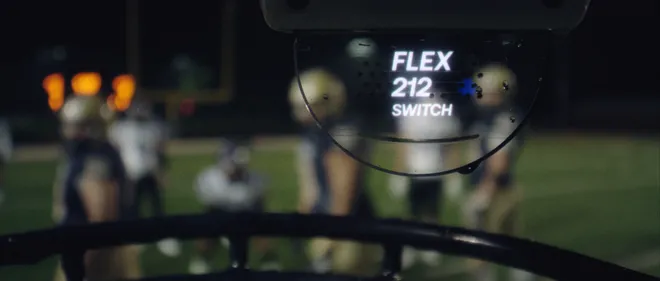
Athletic director Warren Keller pondered how the helmet could have a positive impact for hearing players as well.
"Just imagine how often in each NFL game, with 80,000 fans screaming in attendance, how many times there's a delay of game, offsides?" he said in ASL through an interpreter. "How many timeouts are burned, how many penalties occur because people are so reliant on being able to hear? But having this visual access and being able to communicate in that way, this technology with Gallaudet's help guiding, this will be able to change the future."
Derek Carr, quarterback of the NFL's New Orleans Saints, recently made headlines when Taysom Hill noticed the ear hole coverings on his helmet. Carr explained to his teammate that they help block out crowd noise.
Smith Kenny said the possibilities for the helmet go beyond football.
"We've had people reach out to us saying, 'Hey, if you think about the capabilities of the helmet, could a 5G-connected helmet improve safety on construction sites or for first responders, or even potentially lead to more job opportunities for the deaf community?'" she shared. "It's incredibly exciting and inspiring."
Who wore the 5G-connected helmet in its first game?
Brandon Washington and Trevin Adams are the Gallaudet quarterbacks for whom the 5G helmets were designed. The helmet is giving them opportunities to shine on a national stage.
They are featured in AT&T's commercial that debuted last week during "College GameDay" showing what the 5G-connected helmet can do. Washington was cheering next to Goldstein as Adams scored a touchdown using the helmet. The background track, "Sound of Silence" is sung by partially-deaf artist Amira Unplugged and all of the promotional videos have open captioning.
Washington, a junior who hails from Citronelle, Ala., wore the helmet in its debut and scored three touchdowns as the Bison beat Hilbert. He offered feedback to the AT&T team as the helmet went through several iterations, including that an early version was too heavy due to a bulky battery pack.
This is his second year playing quarterback after Goldstein moved him from wide receiver because of depth needs.
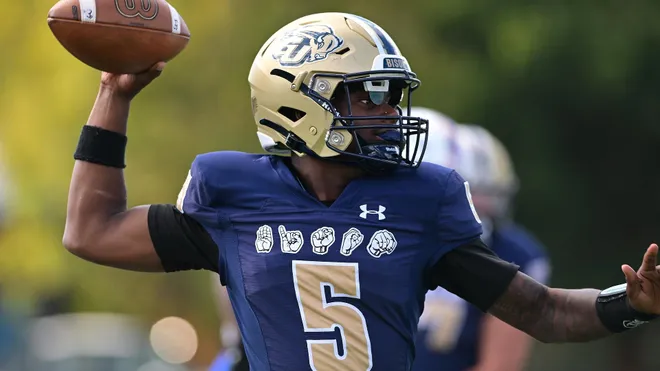
"At first, I was telling him, 'Nah, nah, I don’t wanna play quarterback,'" Washington told USA TODAY Sports. "But then, you know, I got over it and I was like, 'Yeah, I do wanna play quarterback because I want to touch the ball.' I want the ball in my hands. I like to score."
He was last year's ECFC Offensive Player of the Year when the team won the conference championship. He had 1,363 yards of total offense on the season, including eight rushing touchdowns.
Last year, Adams captured the eight-man football championship with the California School for the Deaf-Riverside to cap off an undefeated season with an 80-26 victory. He wanted to attend Gallaudet because both of his parents went there, and his father played football for the Bison. The family attended a celebration for the school's 150th anniversary, which was observed through the 2013-14 school year, and Adams wanted to carry on the tradition.
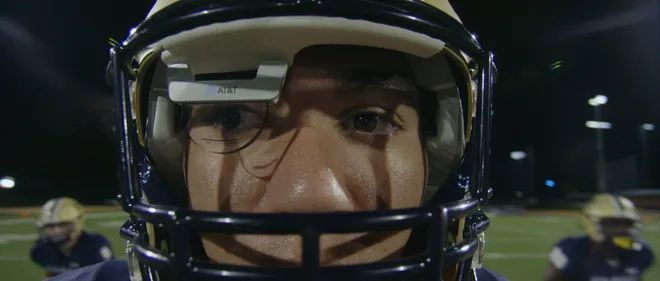
"I knew this was going to be the university I was gonna go to," Adams said in ASL through an interpreter. "And it's just top notch, 100% deaf access, all the teachers can sign, everybody. It is all ASL access everywhere and I just thought I knew that this was going to be my university. And now here I am a student and I've loved it. Gallaudet just is awesome."
"Trevin coming in, and as a freshman, has really been a blessing," Goldstein said. "He is the future of this program, of this team, of this community. He’s great. The future is really looking good. We're OK, we're gonna be in good hands for the next four more, three more years after this."
What improvements are still needed to level playing field for deaf and hard-of-hearing athletes?
Gallaudet prides itself on being at the forefront of innovation to create equality for the deaf and hard-of-hearing community.
The school’s president, Roberta “Bobbi” Cordano, is the first deaf woman and first openly LGBTQ person to hold the position. She was named one of USA TODAY's Women of the Year for her leadership.
"I think it's the daily work of being president of Gallaudet to advance equality. That's my job. That's what I do," she said. "And to make sure that our students have the opportunity and the preparation and the tools they need to go out into the world and thrive. That's advancing equality."
While the 5G-connected helmet is a major breakthrough, there is still a ways to go in leveling the playing field for deaf and hard-of-hearing athletes.
"I wanna make sure people understand: Our players, no matter what, any game we show up, it doesn’t matter who the opponent is or who we have on our roster, we’re never gonna have a level playing field. We just won’t," Goldstein said. "There is a communication barrier."
One of those barriers is with officials who don't sign.
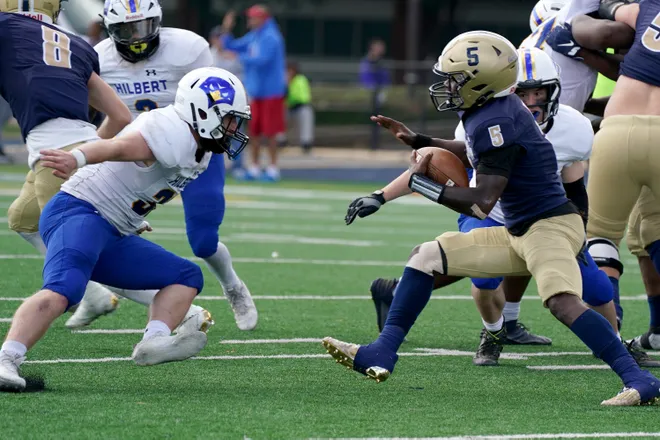
"An official can tell a hearing player on the other team to scoot back or, 'Hey watch your hands on this' or 'Don’t do that,'" Goldstein said. "If he does communicate that with our players, our player’s probably reading his lips, and that’s not fair."
Gallaudet's players also can't hear a whistle being blown, which can be a safety issue.
"If somebody, the whistle’s blown and somebody makes an athletic move on the other team, we’re going to tackle him, always," the coach continued. "I tell our players, 'That’s the one thing I’m not gonna get mad at you about, if you tackle somebody late. Because we’d rather get a 15-yard penalty compared to six points that we give up.'"
And while the helmet helps with player-coach communication, it was only authorized by the NCAA for use in one game and was only worn by the quarterback.
"So this technology is gonna help bridge the gap to a level playing field, it’s gonna help us get closer," he said, "but until I can put every player in one of these helmets — and who knows 20 years from now if this is something that will be used at every level of football — it’s just gonna help bridge the gap and it’s gonna make a difference for us."
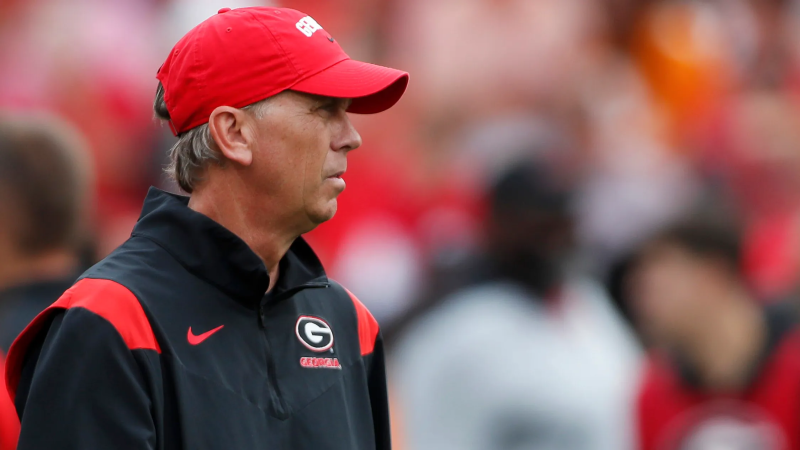
Disclaimer: The copyright of this article belongs to the original author. Reposting this article is solely for the purpose of information dissemination and does not constitute any investment advice. If there is any infringement, please contact us immediately. We will make corrections or deletions as necessary. Thank you.







